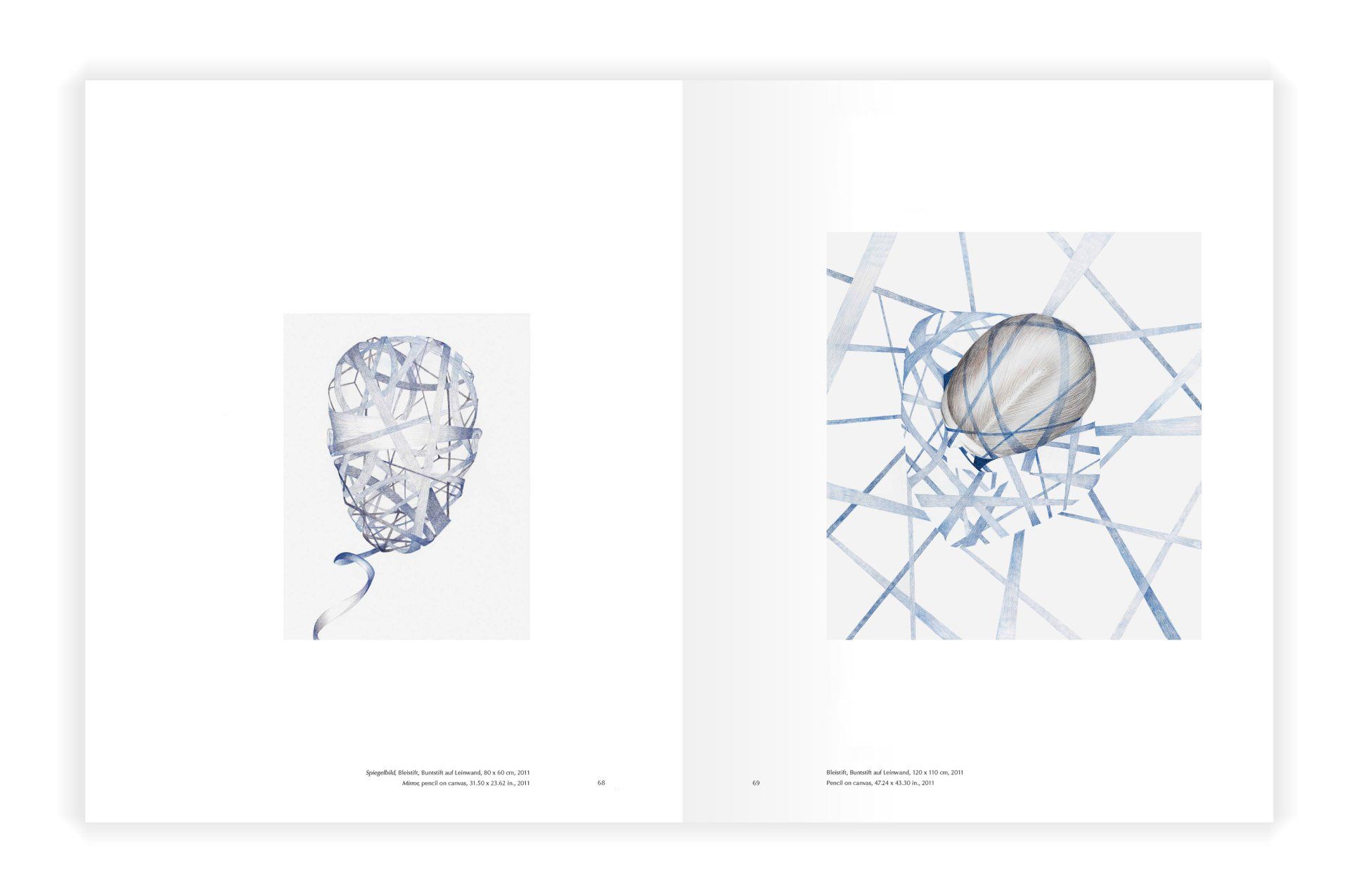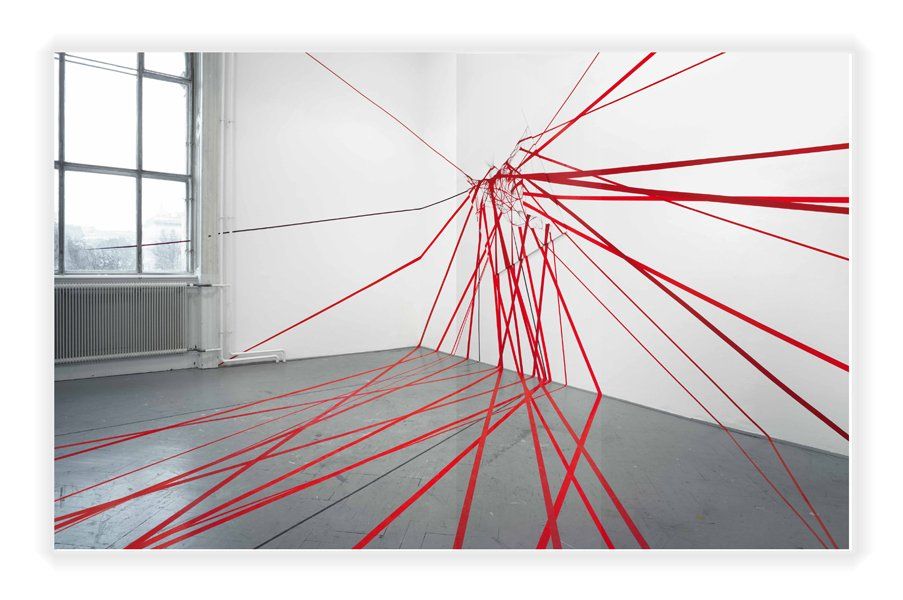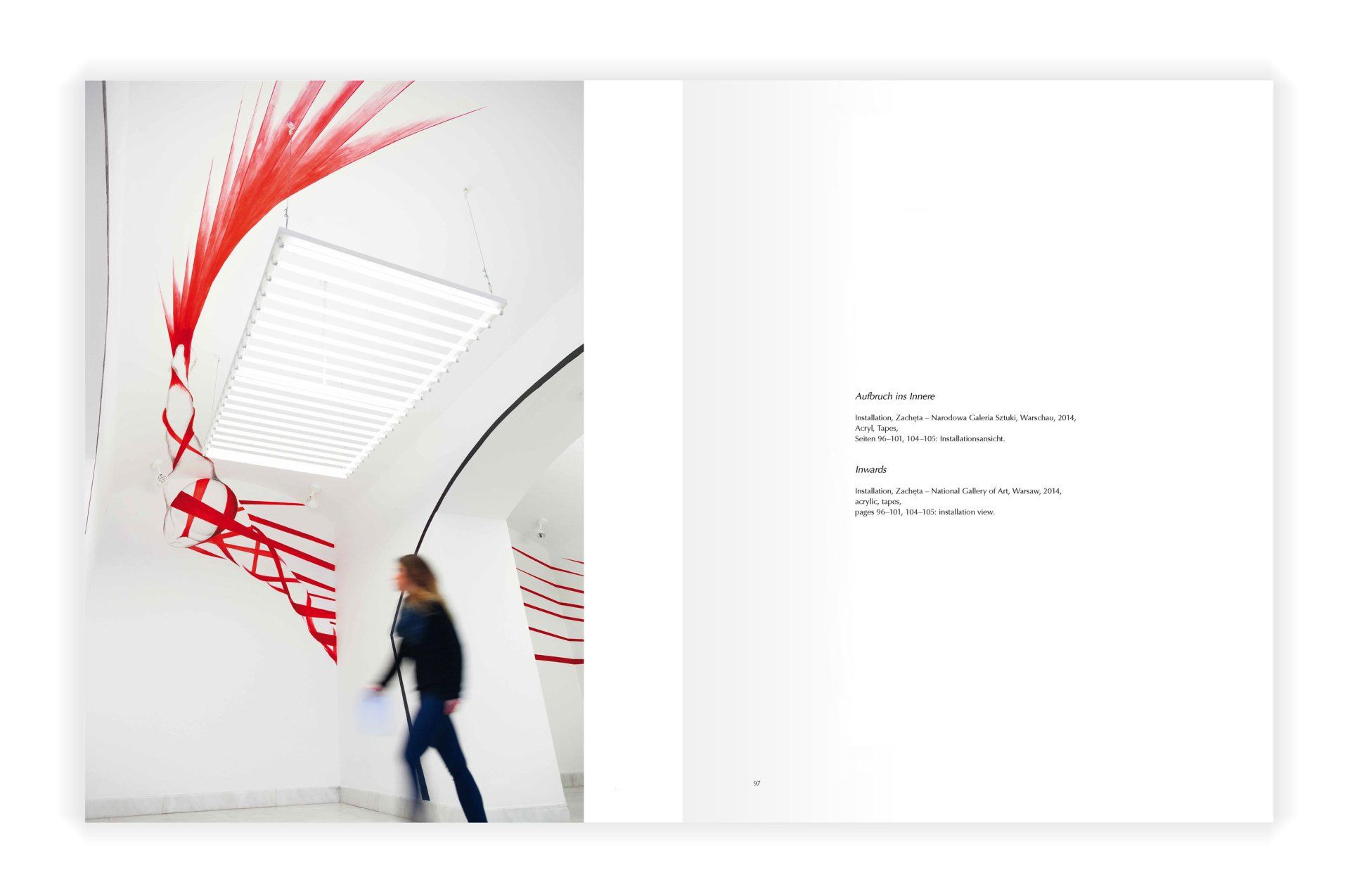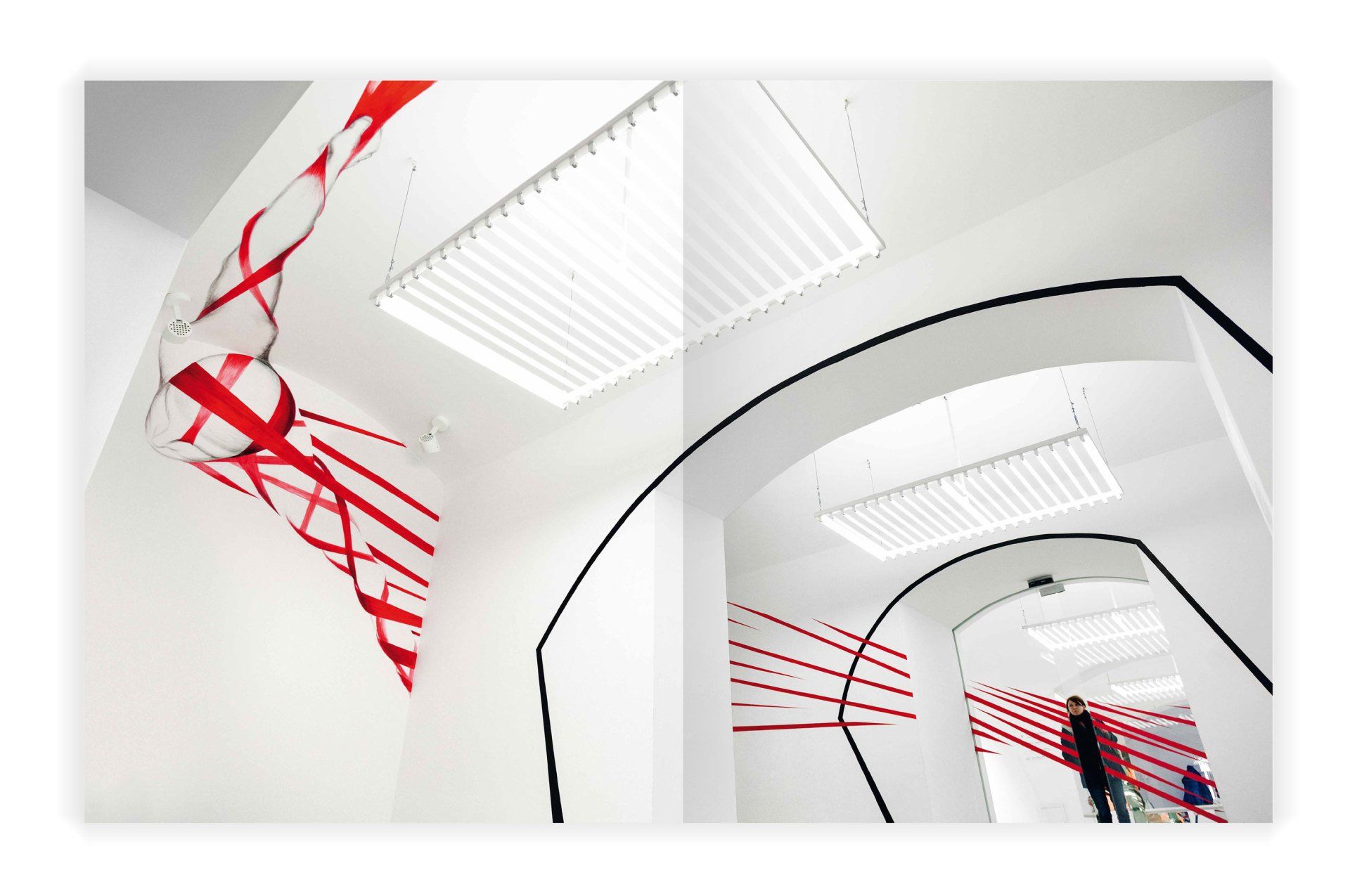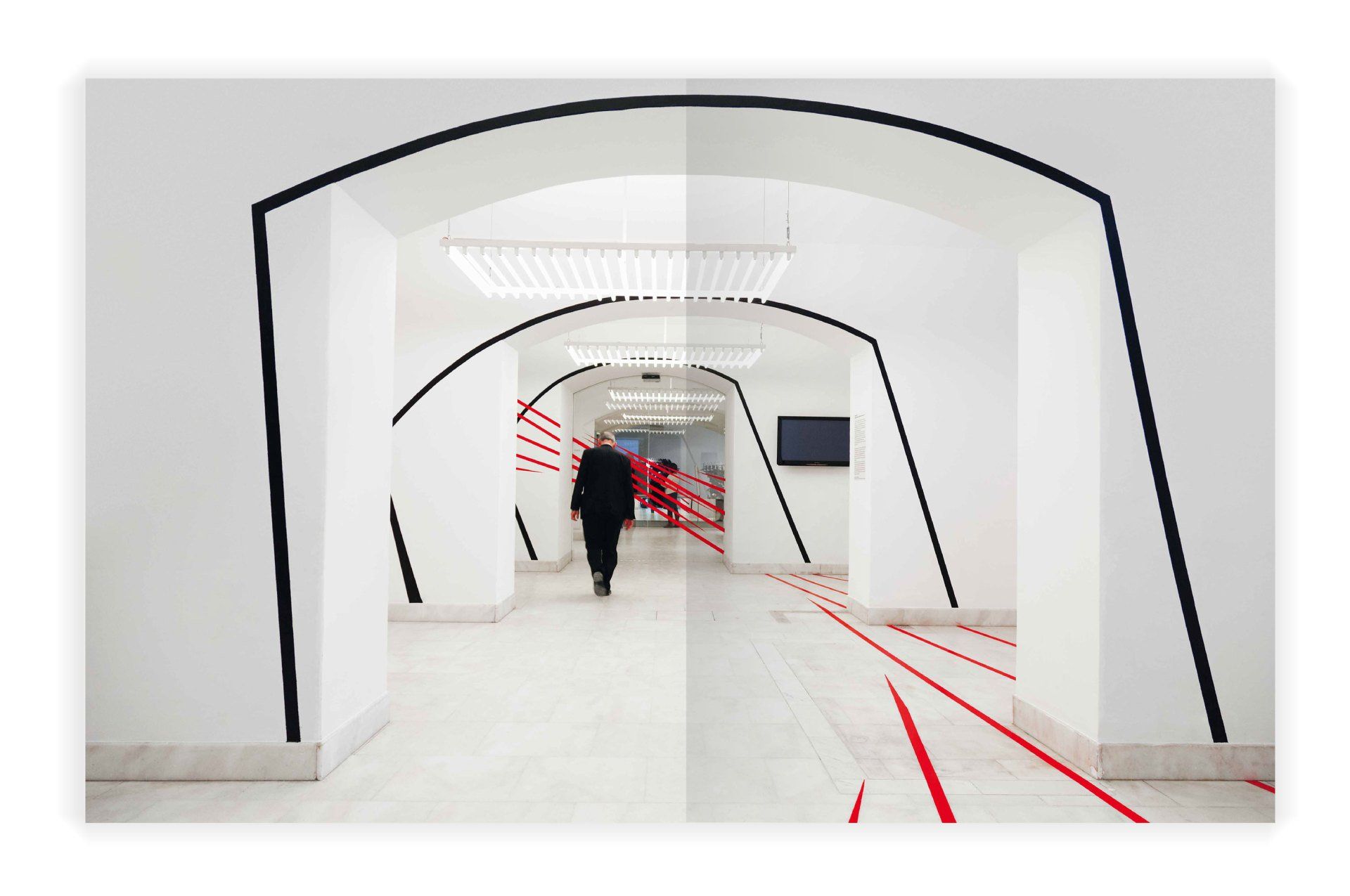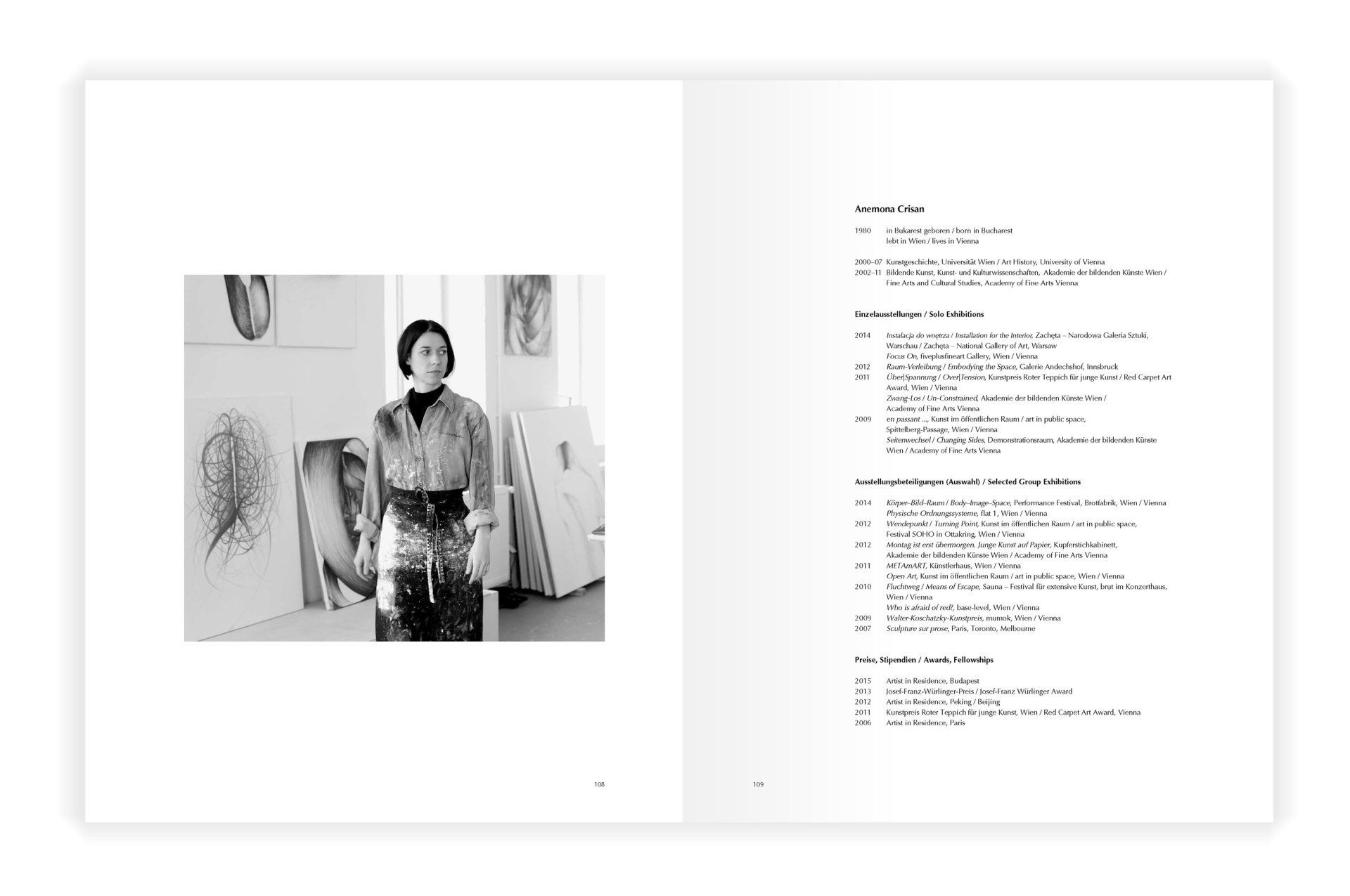
TEXTS SITE SPECIFIC WORKS
Embodied Space
Connie Cossa (in ANEMONA CRISAN, Die Anatomie des Raums / The Anatomy of Space, Conny Cossa (Ed.), Kerber Verlag, Berlin 2014, pp. 7-11.)
A first impression might give one the idea that poetical equilibrium and esthetic elegance lie at the core of Anemona Crisan's works. But underneath the perfect surface of her virtuosic drawings, paintings, and immersive spatial works pulsates a dynamic existential conflict, in almost explosive slow-motion: the conflict be-tween body and space.
Anemona Crisan’s pictorial worlds oscillate between figurative and abstract. In them, she negotiates questions of identity: the battle of the individual against a system which, though defined by him or herself, is still constricting and confining. Her often androgynous, stereotypical figures are covered by plastic structures, penetrated, wrapped—they appear at once threatened and protected. These structures remain ambivalent, like the societal system that influences us and is likewise influenced by us, that is at the same time both home and battlefield. They are like a visualized net of interhuman relationships, like the flip-flopping of passionate love and cold control: woven by individuals, yet of a complexity that exceeds them. But the concrete significance of these structures remains unspeci-fied: do they stand for societal, political, religious interferences? Do they symbol-ize interferences from the outside, or are they parts of the body itself? Are they ropes, fibers, shells, or maybe blood vessels and nerve tracts?
In her early works Anemona Crisan already focused on the relationship between body and space, between individual and society. But this relationship is not limited to the depiction of a body's movement in space, as it is, for example, in Marcel Duchamp’s iconic
Nu descendant un escalier no. 2: Crisan rather moots space, sounds its boundaries. Even though her works rarely hint at concrete spatial coordinates, space itself is always present: whether as pictorial space in her drawings and paintings, or as corporeal space in her installations.
For Anemona Crisan the body is not just a vertical element, corresponding to our human habits of viewing and movement; rather, it merges with the space into a plastic whole. For her, the body is not just personal and individual, but also generic and societal. Somewhat like a Russian matryoshka doll, the body morphs into space, space into body. This boundary between corporeal space and spatial body, the dialectic between inside and outside, becomes the decisive constant. Through subtle, well-calculated deceptions, the artist tries to derange our trained sensual apparatus, so used to organizing the stimuli surrounding us into some kind of system. She challenges the spatial shell, which is always also a corporeal shell. She tries to tilt the horizon and to bend the vertical, tries to make you experience the narrowness and expanse of space, to overcome heaviness, to confound the habits of perception and cenesthesia. This results in a feedback between body and space, between inside and outside—a feedback that can be defined, in the words of Maurice Merleau-Ponty as “reciprocal insertion and intertwining of one in the other”:
“[The body] is not simply a thing seen in fact (I do not see my back), it is visible by right, it falls under a vision that is both ineluctable and deferred. Conversely, if it touches and sees, this is not because it would have the visibles before itself as objects: they are about it, they even enter into its enclosure, they are within it, they line its looks and its hands inside and outside. If it touches them and sees them, this is only because, being of their family, itself visible and tangible, it uses its own being as a means to participate in theirs . . . My body as a visible thing is contained within the full spectacle. But my seeing body subtends this visible body, and all the visibles with it. There is reciprocal insertion and intertwining
of one in the other.“
(1)
Central to Anemona Crisan’s art is thus not only space itself, not the composition of cubic or square meters, nor only the focus on the body as isolated object in space; her installations are rather an etude in corporeality, where space itself
becomes an immersive body. This body-related cognition, the “reciprocal insertion and intertwining,” becomes palpable in all her works, whether in her delicate drawings, her paintings, or her installations. Her approach is in a sense always anatomical, not in the medical-biological sense, but rather in a literal one: the term anatomy derives from Greek ἀνά ‘on, upon’ and τομή ‘cut’, and it is precisely the artistic dissection, the ‘cutting’ of the body, whether the individual one, the flesh, or the societal body, that attracts Anemona Crisan's attention.
The space itself becomes an extension of the body, a prosthesis, and at the same time the body becomes a space, or even more, an anthropogenous landscape. She dissects the existential, transcendent body of the humane itself. Her work makes tangible what Hermann Schmitz called “absolute space.”
Anemona Crisan sets a counterpoint to the bodiless white cube, she brings the virtual pictorial space into relationship with the exhibition room. This ‘inter-space,’ so essential to her artistic work, already became an object of research in her early works, for example, in the installation
en passant ... in the Spittelberg Passage in Vienna from 2009. The focal point of her first spatial works, for example Who is afraid of red? from 2010 (pp. 28–33) or her diploma project Zwang-Los / Un-Constrained at the Vienna Academy of Fine Arts from 2011, is still the classic medium of the ‘panel painting,’ the canvas. But she refuses to be content with this limited surface: her work trespasses, ignores the frame, seizes the space. Traditionally, the viewers stand in front of an image; now they find themselves immersed in it. The spectator's pulsing blood and Anemona Crisan's fine trajectories merge into one single body. The image protrudes into space, and space penetrates into the image. Thanks to a shift of focus, in which the artist functions as a kind of microscope, the viewer becomes part of the work. The space embodies itself.
The artist breaks with the dogma of hanging paintings at eye level. She forces the viewers to pace across the space and to grasp it through movement. The work is no longer determined by the spatial shell, but rather disguises and distorts it—the artist spreads an emotional space onto the ‘factual’ space, toys with closeness and distance, with confinement and dissolution. This ambivalent situation of the body was addressed by Wolfgang Meisenheimer:
“The interior space as shell is . . . in no way a physical shell, a bag that holds the things together and can be measured in cubic meters. It is rather the potential sphere surrounding my own self, the stage that architecture provides for my flesh. It is not a material, but a scenic proposal . . . The flesh has a vital interest in the shell, the skin, the protection of its sphere. But it has an equally strong interest in expanding: stretching into the unknown, penetrating the shell.” (2)
In her installation
Über|Spannung / Over|Tension from 2011, created as part of the initiative Red Carpet Art Award in Vienna, Anemona Crisan refrained from the medial transgression of image and space and concentrated on the theme of spatial embodiment. In her previous installations, the panel painting was the focal point of the dynamic between expansion and contraction. Now we witness once again a shift of focus: image and space merge into one; they form a new spatial experience whose focus and context is the body itself. The artist has described this aptly:
“The figure grasps the space, occupies, shifts and tilts it. Through the red lines, it connects the architecture to its own body and assimilates the surrounding space. The installation spreads a virtual onto the factual space. There are points where these two spaces overlap, and other points where the constructed space exceeds the factual one, strays like a trompe l'oeil against its spatial parameters. At the same time the installation is walkable, the viewer becomes part of the work, per-ceiving it physically.”
(3)
For Anemona Crisan, the sublime mastery of artistic techniques is only a means to an end. It is essentially irrelevant if she uses tapes in an installation, or tracks her lines across the walls with a virtuosic brush stroke in week-long efforts, as was the case in the installation Raum-Verleibung / Embodying the Space at the Galerie Andechshof in Innsbruck in 2012, or her installation
Inwards at the Zachęta – National Gallery of Art in Warsaw in 2014.
Her approach is much rather of a psychological-analytical nature, and her work a balancing act between precision and gesture, control and eruption, technique and impulse.
1 Maurice Merleau-Ponty, The Visible and the Invisible, ed. Claude Lefort, Evanston 2007, pp. 137–138.
2 Wolfgang Meisenheimer, Das Denken des Leibes und der architektonische Raum, Cologne 2004, p. 41, translated by the author.
3 Interview between Anemona Crisan and Conny Cossa, December 2013, translated by the author.
This text is printed in the artist's catalog below and can be purchased here:
ANEMONA CRISAN
The Anatomy of Space
This monograph traces the development of the Austrian-Romanian artist Anemona Crisan from panel painting to large-scale installation. It shows Crisan's idiosyncratic perception of the relationship between body and space: her drawings expand into space, take possession of it and embrace the viewer. In her works on paper, canvas and in expansive installations, she uses concise lines that redefine space with stylized anatomical elements.
Editor: Conny Cossa
With text contributions from: Conny Cossa, Elisabeth Priedl and Jacek Malinowski
Kerber Verlag, Berlin, 2014
Hardcover, 30 x 24 cm, 112 pages
Languages: German / English
ISBN: 978-3-86678-985-2
≫ order







